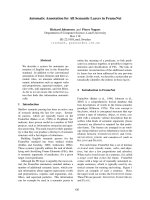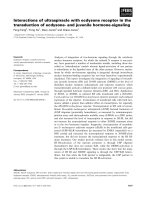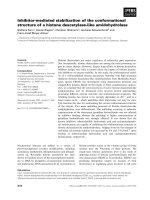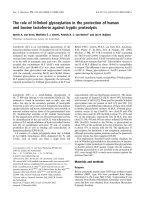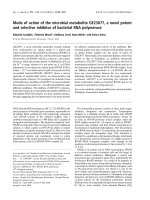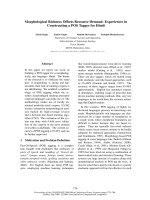Báo cáo khoa học: "Surfactant therapy for acute respiratory failure in children: a systematic review and meta-analysis" pptx
Bạn đang xem bản rút gọn của tài liệu. Xem và tải ngay bản đầy đủ của tài liệu tại đây (670.42 KB, 10 trang )
Open Access
Available online />Page 1 of 10
(page number not for citation purposes)
Vol 11 No 3
Research
Surfactant therapy for acute respiratory failure in children: a
systematic review and meta-analysis
Mark Duffett
1
, Karen Choong
1
, Vivian Ng
2
, Adrienne Randolph
3
and Deborah J Cook
4
1
Department of Critical Care, McMaster Children's Hospital, 1200 Main St. W., Hamilton, Ontario L8S 4J9, Canada
2
Grand River Hospital, 835 King St. West, Kitchener, Ontario N2G 1G3, Canada
3
Children's Hospital Boston, 300 Longwood Avenue, MSICU, FA-108, Boston, MA 02115, USA
4
Department of Clinical Epidemiology and Statistics, McMaster University, 1200 Main St. W., Hamilton, Ontario L8N 3Z5, Canada
Corresponding author: Mark Duffett,
Received: 16 Mar 2007 Revisions requested: 13 Apr 2007 Revisions received: 11 May 2007 Accepted: 15 Jun 2007 Published: 15 Jun 2007
Critical Care 2007, 11:R66 (doi:10.1186/cc5944)
This article is online at: />© 2007 Duffett et al., licensee BioMed Central Ltd.
This is an open access article distributed under the terms of the Creative Commons Attribution License ( />),
which permits unrestricted use, distribution, and reproduction in any medium, provided the original work is properly cited.
Abstract
Introduction Exogenous surfactant is used to treat acute
respiratory failure in children, although the benefits and harms in
this setting are not clear. The objective of the present systematic
review is to assess the effect of exogenous pulmonary surfactant
on all-cause mortality in children mechanically ventilated for
acute respiratory failure.
Methods We searched the MEDLINE, EMBASE, CINAHL and
Ovid Healthstar databases, the bibliographies of included trials
and review articles, conference proceedings and trial registries.
We included prospective, randomized, controlled trials of
pulmonary surfactant that enrolled intubated and mechanically
ventilated children with acute respiratory failure. We excluded
trials that exclusively enrolled neonates or patients with asthma.
Two reviewers independently rated trials for inclusion, extracted
data and assessed the methodologic quality. We quantitatively
pooled the results of trials, where suitable, using a random
effects model.
Results Six trials randomizing 314 patients were included.
Surfactant use reduced mortality (relative risk = 0.7, 95%
confidence interval = 0.4 to 0.97, P = 0.04), was associated
with increased ventilator-free days (weighted mean difference =
2.5 days, 95% confidence interval = 0.3 to 4.6 days, P = 0.02)
and reduced the duration of ventilation (weighted mean
difference = 2.3 days, 95% confidence interval = 0.1 to 4.4
days, P = 0.04).
Conclusion Surfactant use decreased mortality, was
associated with more ventilator-free days and reduced the
duration of ventilation. No serious adverse events were reported.
Introduction
Acute respiratory failure remains the primary indication for
admission to North American paediatric intensive care units
(PICUs) and accounts for significant mortality, morbidity and
resource utilization [1]. Respiratory infections, in particular
pneumonia and severe bronchiolitis, are the most common
causes of respiratory failure requiring mechanical ventilation in
children [1].
Alterations in endogenous surfactant play a role in the patho-
genesis of many causes of acute lung injury (ALI) and acute
respiratory distress syndrome (ARDS) [2]. Surfactant dysfunc-
tion, destruction and inactivation have also been demon-
strated in children with acute respiratory insufficiency due to
bronchiolitis [3,4]. The administration of exogenous surfactant
may reduce the need for mechanical ventilation and its associ-
ated sequelae by restoring surfactant levels and function.
Inspired by the success of surfactants in reducing mortality
and the need for mechanical ventilation in neonatal respiratory
distress syndrome [5], investigators have studied exogenous
surfactant in other populations with various causes of respira-
tory failure. Trials of surfactant in adults with ALI and ARDS
have not demonstrated a mortality benefit [6-9], perhaps due
to inherent differences in the aetiology of lung injury in adults,
the design features of the trials, the mode and timing of sur-
factant administration or the type and dose of surfactant used.
In children with respiratory failure, the efficacy of exogenous
surfactant has been suggested in uncontrolled studies
ALI = acute lung injury; ARDS = acute respiratory distress syndrome; FiO
2
= fractional inspired oxygen; PaO
2
= arterial oxygen tension; PICU = pae-
diatric intensive care unit; RSV = respiratory syncytial virus.
Critical Care Vol 11 No 3 Duffett et al.
Page 2 of 10
(page number not for citation purposes)
[10,11]. The relatively low mortality rate, the diversity of the
study populations and the shorter duration of mechanical ven-
tilation are factors that make large-scale randomized control-
led trials in this population challenging to conduct. Two of the
largest trials were stopped early due to slower than expected
enrolment [12,13]. While the use of surfactant in ARDS/ALI
has not been previously systematically reviewed, its use in chil-
dren with bronchiolitis has been [14].
We anticipated that including trials enrolling children with
acute respiratory failure from a variety of causes would result
in a heterogeneous population and would increase the gener-
alizability of the results. Our confidence in the results of the
present review would also be increased if a consistent effect
is shown in subgroups and across a spectrum of disease
severity.
The primary objective of the systematic review is to assess the
effect of the administration of pulmonary surfactant compared
with no therapy or with placebo on all-cause mortality (at or
before hospital discharge) in mechanically ventilated children
with acute respiratory failure.
Methods
Trial selection
We included trials that were prospective, that were rand-
omized, that enrolled children intubated and mechanically ven-
tilated for acute respiratory failure and that compared the
intratracheal administration or nebulization of at least one dose
of natural or artificial pulmonary surfactant with a placebo or no
intervention. We excluded trials exclusively enrolling neonates
or patients with asthma. We used the trial authors' definitions
of paediatric.
Outcome measures
The primary outcome measure was all-cause mortality at or
before hospital discharge. Secondary outcomes were ventila-
tor-free days to day 28 (a composite of mortality and duration
of ventilation, defined as days alive and free from mechanical
ventilation) [15], the duration of mechanical ventilation (from
intubation to extubation, death or trial withdrawal), the duration
of PICU stay, the use of rescue therapy (such as extracorpor-
eal membrane oxygenation, high-frequency oscillatory ventila-
tion, open label surfactant and nitric oxide), and complications
and adverse effects as reported by the trial authors.
Searching
One of us searched for published and unpublished trials,
examining trial registries, conference proceedings and the bib-
liographies of any identified trials and relevant reviews (the
search strategy is available upon request). We polled paediat-
ric intensivists and pharmacists at our institution for additional
trials. We selected search terms from the keywords and
MESH terms of previous surfactant trials and from the generic
and brand names of commercially available surfactants. We
imposed no language restrictions.
Trial selection
One of us screened the title (and abstract if required) of all
citations retrieved. We selected citations for further evaluation
if they reported the administration of at least one dose of sur-
factant to at least one child or if the title or abstract did not give
enough information to make an assessment. Two reviewers
independently reviewed all citations meeting criteria for further
review and applied the inclusion criteria. Disagreements
between reviewers were resolved by consensus in consulta-
tion with a third reviewer. We considered agreement between
reviewers to be acceptable if the kappa value was greater than
0.8.
Quality assessment
We used the following characteristics to assess the methodo-
logic quality: allocation concealment (sealed envelopes or
central randomization were considered adequate), blinding
(which of the trial personnel and caregivers were blinded, and
the methods used to ensure blinding), completeness of follow-
up (assessed by the number of patients randomized for whom
there were no outcomes), similarity of the groups at baseline
(with respect to known prognostic factors: age, aetiology,
severity of illness as measured by the Pediatric Risk of Mortal-
ity score, and immunosuppression), whether a standard or rec-
ommended strategy for mechanical ventilation was used, and
whether a priori criteria for the use of co-interventions were
used. Effective blinding of surfactant is challenging because of
the large volumes of milky fluid administered, which can often
be seen by caregivers in the patients' ventilator tubing or
endotracheal tube, particularly during suctioning.
We pretested and refined the developed forms on two trials of
surfactant therapy for adults, and clarified definitions based on
feedback from the reviewers. Two reviewers then independ-
ently used these forms to abstract trial quality, blinded to the
authors, the journal, the country of origin and the results. We
resolved any disagreements by consensus in consultation with
a third reviewer if needed.
Data abstraction
After pretesting and refining the forms on two trials of sur-
factant therapy in adults and clarifying definitions based on
feedback from the reviewers, two reviewers then independ-
ently abstracted the data. Reviewers were only provided with
a full-text version of the trials from which the introduction, con-
clusions and discussion were omitted and from which the
author, journal and country of origin were deleted. We thereaf-
ter examined these sections of the reports for any missing
data. We resolved any disagreements between reviewers by
consensus in consultation with a third reviewer if needed. We
asked the authors to supply data not included in the published
reports. Two reviewers performed data entry in duplicate.
Available online />Page 3 of 10
(page number not for citation purposes)
Statistical methods
We quantitatively pooled the results of individual trials when
possible. We expressed the treatment effect as a relative risk
for dichotomous outcomes and as a weighted mean difference
for continuous outcomes with 95% confidence intervals. We
considered effects statistically significant if P < 0.05. A z test
was used to statistically test the estimates of treatment effect
between groups [16]. We assessed heterogeneity among tri-
als using the I
2
statistic, and considered an I
2
value greater
than 50% to indicate substantial heterogeneity [17]. RevMan
4.2 software and a random effects model were used to per-
form the analyses [18]. We chose the random effects model
because it gives a more conservative estimate of the precision
of the treatment effects and because the true effect of the
intervention probably varies given the different populations
enrolled in these trials [19]. A subgroup analysis was planned
based on the aetiology of respiratory failure (trials enrolling
exclusively patients with respiratory syncytial virus (RSV)/
severe bronchiolitis compared with all other trials) if sufficient
data were available, because these trials were likely to enrol a
younger, more homogeneous, population with a lower pre-
dicted risk of mortality. We also planned sensitivity analysis
based on methodological features of the included trials (trials
reporting adequate allocation concealment compared with all
other trials).
Results
Trial flow
We identified 742 unique citations, six of which met our inclu-
sion criteria (Figure 1 outlines the reasons for exclusion). Most
reports excluded enrolled neonates or were retrospective or
uncontrolled in design. Chance corrected agreement was
excellent (kappa = 0.91, 95% confidence interval = 0.73–
1.1).
Methodologic quality of included trials
Table 1 presents a complete description of our quality assess-
ment. Only one trial did not report allocation concealment [20].
Although effective blinding of surfactant is challenging, two tri-
als reported blinding of the PICU team [12,20]. The two
Figure 1
Flow diagram of included trialsFlow diagram of included trials. RCTs, randomized controlled trials.
Table 1
Trial methodological quality
Trial Allocation
concealment
reported? (Method
used)
Who was reported to be
blinded? (Who
administered the
intervention?)
Completeness of
follow-up reported?
a
Groups similar at
baseline?
b
Ventilation algorithm
described?
Criteria for rescue
therapy
c
Luchetti, 1998 Yes (sealed
envelopes)
Not reported Not reported Yes Yes Not reported
Willson, 1999 Yes (opaque sealed
envelopes)
Unblinded 91% Lower PRISM scores
in control group (9
versus 12)
Yes No
Tibby, 2000 Not reported Care providers
(investigators not involved
in patient care)
Not reported Yes Yes Not reported
Luchetti, 2002 Yes (sealed
envelope)
Outcome assessors
(investigators)
Not reported Yes Yes No
Moller, 2003 Yes (central
telephone)
Unblinded 87% Yes Yes Yes
Willson, 2005 Yes (opaque sealed
envelopes)
Care providers,
investigators (respiratory
therapist not involved in
patient care)
100% More
immunosuppressed
in control group (30
versus 22)
Yes No
a
Patients randomized but not included in the analysis.
b
Potentially clinically significant differences in age, aetiology, severity of illness (Pediatric Risk of Mortality
(PRISM) score) and immunosuppression.
c
A priori criteria for the use of extracorporeal membrane oxygenation, high-frequency oscillatory ventilation, nitric oxide and
open-label surfactant.
Critical Care Vol 11 No 3 Duffett et al.
Page 4 of 10
(page number not for citation purposes)
groups were generally well matched in terms of baseline char-
acteristics in most trials. The most significant imbalance was
the numerically higher number of immunosuppressed patients
in the placebo group. These patients had higher mortality
(56%) than the immunocompetent group (13%). The authors
attempted to adjust for this imbalance with logistic regression,
which suggested that the treatment effect seemed to be rela-
tively consistent between the two groups [12]. Only one trial
reported a priori criteria for rescue therapy [13].
Description of included trials
Table 2 describes the included trials. Three trials enrolled
exclusively infants with RSV-induced respiratory failure
[20,21] or with severe bronchiolitis [22]. The remaining three
trials enrolled a heterogeneous group of patients with ARDS
or ALI [12,23,24]. While the individual treatment protocols var-
ied, all trials used comparable doses (50–100 mg/kg phos-
pholipids) of natural or modified natural surfactants and each
patient typically received one or two doses. A variety of inter-
ventions were used in the control groups: no intervention, air
placebo or similar sedation and ventilation manoeuvres with-
out a placebo. Although one study [20] used a modified natu-
ral surfactant, all the products used contained surfactant
proteins B and C. All studies administered surfactant early in
the course of respiratory failure; most patients were treated
within 12–48 hours of requiring mechanical ventilation.
The baseline characteristics of the patients are presented in
Table 3. While there was significant heterogeneity among and
within trials with respect to age and cause of respiratory fail-
ure, we considered the initial Pediatric Risk of Mortality scores
and the initial PaO
2
/FiO
2
ratios to be clinically comparable.
Primary outcome: mortality
Mortality data were available for all six trials, randomizing 311
patients and reporting data for 305 patients. There were no
deaths reported in the three RSV/severe bronchiolitis trials;
thus our estimate is based on three trials randomizing 232
patients, 64 of whom died. In the pooled analysis, surfactant
was associated with significantly lower mortality (relative risk
= 0.7, 95% confidence interval = 0.4–0.97, P = 0.04). There
was no evidence of heterogeneity (I
2
= 0%) (Figure 2).
Secondary outcomes
Ventilator-free days to day 28
The number of ventilator-free days to day 28 was available for
six trials randomizing 311 patients and reporting data for 305
patients. In the pooled analysis, surfactant was associated
with significantly more ventilator-free days (weighted mean dif-
Table 2
Summary of trial design
Trial Patient
population
a
Number of
centres
Surfactant
(dose
b
)
Control Primary outcome Duration of follow-
up
Funding source
Luchetti, 1998 Severe
bronchiolitis
Unclear, probably
1
Poractant –
porcine
(50 mg/kg single
dose)
None Unclear PICU discharge Not reported
Willson, 1999 ARDS/ALI 8 Calfactant –
bovine
(2,800 mg/m
2
every 12 hours for
1–4 doses)
None Mortality Hospital
discharge
Partial support by
surfactant
manufacturer
Tibby, 2000 RSV-induced
respiratory failure
Unclear, probably
1
Beractant –
modified bovine
(100 mg/kg every
24 hours for 2
doses)
Air placebo Indices of gas
exchange
Hospital
discharge
Not reported
Luchetti, 2002 RSV-induced
respiratory failure
6 Poractant –
porcine
(50 mg/kg dose
every 24 hours for
1–2 doses)
Sedation and
manual ventilation
Vent days and
PICU stay
PICU discharge Not reported
Moller, 2003 ARDS 19 Bovactant –
bovine
(100 mg/kg, 1–2
doses within 48
hours)
None Change in PaO
2
/
FiO
2
at 48 hours
30 days Surfactant
manufacturer
Willson, 2005 ARDS/ALI 21 Calfactant –
bovine
(2,800 mg/m
2
– if
<10 kg, 105 mg/
kg – every 12
hours for 1–2
doses)
Air placebo Ventilator-free
days at day 28
Hospital
discharge
Surfactant
manufacturer
ALI, acute lung injury; ARDS, acute respiratory distress syndrome; PICU, paediatric intensive care unit; RSV, respiratory syncytial virus.
a
See Additional file 1 for the
complete inclusion criteria and exclusion criteria.
b
Dose expressed as mg/kg phospholipids.
Available online />Page 5 of 10
(page number not for citation purposes)
ference = 2.5 days, 95% confidence interval = 0.3–4.6 days,
P = 0.02) (Figure 3).
Duration of mechanical ventilation
The duration of mechanical ventilation was available for six tri-
als randomizing 311 patients and reporting data for 305
patients. In the pooled analysis, surfactant was associated
with a significantly shorter duration of mechanical ventilation
(weighted mean difference = 2.3 days, 95% confidence inter-
val = 0.1–4.4 days, P = 0.04) (Figure 4).
Duration of PICU stay
The duration of PICU stay was available for five trials randomiz-
ing 273 patients and reporting data for 272 patients. In the
pooled analysis, surfactant was associated with a shortened
duration of PICU stay (weighted mean difference = 2.6 days,
95% confidence interval = 0.02–5.2 days, P = 0.05), but this
difference was not statistically significant (Figure 5).
Use of rescue therapy
Data on the use of rescue therapy were available for six trials
randomizing 311 patients and reporting data for 305 patients.
In the pooled analysis, the surfactant was associated with a
significantly lower use of rescue therapy (relative risk = 0.4,
95% confidence interval = 0.3–0.7, P < 0.0001). There was
no evidence of heterogeneity (I
2
= 0%). This summary esti-
mate should be interpreted with caution as only one trial
reported a protocol for initiating rescue therapy. The decision
to use a rescue therapy, particularly an open-label surfactant,
may be influenced by knowledge of the patient's allocation;
furthermore, only two trials reported blinded caregivers and
the methods used to ensure blinding may not be adequate.
Adverse events
Surfactant therapy was well tolerated (see Table 4), but only
three of the trials reported any definitions or a priori criteria or
of collecting adverse events [12,21,23]. Transient hypoten-
sion and transient hypoxia were the most commonly reported
adverse events in the largest trial. These responded to a brief
adjustment in ventilation, to a slowing of the rate of surfactant
administration or to fluid administration. There was no
difference in the incidence of air leaks in the two trials that
reported this outcome. No patient was withdrawn from any of
the trials because of adverse events. We did not pool the data
Table 3
Baseline characteristics
Trial Aetiology of respiratory failure
a
Treatment group Age (years) Initial PaO
2
/FiO
2
PRISM score
Luchetti, 1998 Bronchiolitis
Pneumonia
100% Surfactant 0.87 (0.15) 118 (15.8) Not reported
50% Placebo 0.93 (0.17) 122 (12.0) Not reported
Willson, 1999 ARDS 31%
Pneumonia 26% Surfactant 5.0 (5.34) 102 (53) 12 (6)
RSV 17% Placebo 4.5 (5.66) 105 (42) 9 (4)
Near-drowning 7%
Sepsis 7%
Other 14%
Tibby, 2000 RSV 100% Surfactant 0.17 (0.14, 0.27)
b
146 (134, 171)
b
11 (11, 15)
b
Placebo 0.13 (0.09, 0.18)
b
160 (106, 205)
b
13 (11, 15)
b
Luchetti, 2002 RSV 100% Surfactant 0.73 (0.675) Not reported 12 (1.1)
Pneumonia 45% Placebo 0.62 (0.542) Not reported 12 (1.2)
Moller, 2003 Pneumonia 68% Surfactant 3.5 (range 0–13) 71 (13.7) 12 (6.5)
Sepsis 32% Placebo 4.5 (range (0–12) 64 (16.2) 11 (4.5)
Willson, 2005 ARDS or sepsis 35% Surfactant 7.2 (6.4) 128 (54) 15 (9.4)
Pneumonia 42% Placebo 6.7 (6.4) 126 (73) 14 (7.9)
RSV 7%
Near-drowning 5%
Other 11%
Values expressed as the mean (standard deviation) unless otherwise indicated. ARDS: acute respiratory distress syndrome; PRISM, Pediatric
Risk of Mortality; RSV: respiratory syncytial virus.
a
Totals may be greater than 100% due to rounding and because multiple aetiologies were
reported for some patients.
b
Median (interquartile range).
Critical Care Vol 11 No 3 Duffett et al.
Page 6 of 10
(page number not for citation purposes)
on adverse events associated with the trial interventions from
the six trials because of the inconsistent manner in which the
events were documented and reported.
Subgroup analysis
The effect of surfactant on ventilator-free days, the duration of
mechanical ventilation and the duration of PICU stay was not
significantly different when we compared the three trials that
enrolled exclusively patients with RSV/severe bronchiolitis
with the three other trials (Table 5). A 100% survival in the
bronchiolitis trials subgroup precludes formal subgroup analy-
sis for the primary outcome of mortality.
Sensitivity analysis
All but one of the included trials reported adequate allocation
concealment (defined as sealed envelopes or central
telephone randomization). Since there were no deaths in this
trial we could not assess the effect of inadequate allocation
concealment on mortality. Pooling the five remaining trials did
not change the direction of the effect and did not significantly
Figure 2
Meta-analysis of trials of surfactant in children with acute respiratory failure: MortalityMeta-analysis of trials of surfactant in children with acute respiratory failure: Mortality. ALI, acute lung injury; ARDS, acute respiratory distress syn-
drome; 95% CI, 95% confidence interval; RR, relative risk; RSV, respiratory syncytial virus.
Figure 3
Meta-analysis of trials of surfactant in children with acute respiratory failure: Ventilator-free daysMeta-analysis of trials of surfactant in children with acute respiratory failure: Ventilator-free days. ALI, acute lung injury; ARDS, acute respiratory dis-
tress syndrome; 95% CI, 95% confidence interval; RSV, respiratory syncytial virus; SD, standard deviation; WMD, weighted mean difference.
Available online />Page 7 of 10
(page number not for citation purposes)
change the point estimates for the secondary outcomes of
ventilator-free days, duration of ventilation or duration of PICU
stay (Table 6).
Discussion
In the present systematic review and meta-analysis of the
effect of surfactant for critically ill children with acute
respiratory failure we found that surfactant therapy signifi-
cantly reduced our primary outcome of mortality. Surfactant
was associated with more ventilator-free days, with decreased
duration of ventilation and with less use of rescue therapy as
compared with standard therapy. There was no significant dif-
ference in the duration of PICU stay. Surfactant therapy was
well tolerated; while transient hypoxia and hypotension were
reported during surfactant administration, no study reported
any serious adverse events. The patients enrolled in these tri-
als are representative of the heterogeneous group of children
with early, severe acute respiratory failure that is seen in clini-
cal practice. These patients had similar severity of illness
scores and a similar degree of respiratory failure (as measured
by Pediatric Risk of Mortality scores and PaO
2
:FiO
2
ratios).
The heterogeneity of results for our primary outcome of mortal-
ity was low. The presence of significant heterogeneity reduces
the strength of inferences we can make regarding the effect of
surfactant on the secondary outcomes of ventilator-free days,
Figure 4
Meta-analysis of trials of surfactant in children with acute respiratory failure: Duration of mechanical ventilationMeta-analysis of trials of surfactant in children with acute respiratory failure: Duration of mechanical ventilation. ALI, acute lung injury; ARDS, acute
respiratory distress syndrome; 95% CI, 95% confidence interval; RSV, respiratory syncytial virus; SD, standard deviation; WMD, weighted mean
difference.
Figure 5
Meta-analysis of trials of surfactant in children with acute respiratory failure: Duration of PICU stayMeta-analysis of trials of surfactant in children with acute respiratory failure: Duration of PICU stay. ALI, acute lung injury; ARDS, acute respiratory
distress syndrome; 95% CI, 95% confidence interval; PICU, paediatric intensive care unit; RSV, respiratory syncytial virus; SD, standard deviation;
WMD, weighted mean difference.
Critical Care Vol 11 No 3 Duffett et al.
Page 8 of 10
(page number not for citation purposes)
duration of ventilation and duration of PICU stay. Separately
pooling the trials that exclusively enrolled patients with RSV/
severe bronchiolitis and those enrolling patients with ARDS/
ALI from a variety of causes did not significantly reduce the
heterogeneity. Changing ventilation strategies and the use of
a variety of natural and modified natural surfactants may have
increased the heterogeneity of our results. Ventilation
strategies, such as the use of lower tidal volumes and earlier
use of high-frequency oscillatory ventilation, have evolved
significantly in the 10-year span over which the included trials
were conducted [25-27]. The surfactants used in the included
trials were all natural or modified natural surfactants; however,
these surfactants may have slightly different effects on oxygen-
ation and compliance due to the differences in phospholipid
and surfactant protein composition, which may have influ-
enced individual study results.
Table 4
Reported adverse events
Trial Adverse events reported
Surfactant (n = 157) Control (n = 150)
Luchetti, 1998 'No adverse haemodynamic effects were noted' 'No complications were reported in either group'
'No complications were reported in either group'
Willson, 1999 One with transient bronchospam One with air leak
Two with air leaks One with air leak and pulmonary interstitial
emphysema
One with pulmonary interstitial emphysema One plugged endotracheal tube
Tibby, 2000 'No complications were noted after surfactant administration' Not reported
Luchetti, 2002 'No complications due to the treatment were observed in the surfactant-
treated group'
' no complications were found in the control
group'
Moller, 2003 'No treatment associated adverse events were observed in the surfactant
group; however, the expected risk of intermittent obstruction of the
endotracheal tube with a short time deterioration on oxygenation was
observed in 3 patients'
Not reported
Willson, 2005 Hypotension 9% Hypotension 1%
Transient hypoxia 12% Transient hypoxia 3%
Air leaks 13% Air leaks 16%
Nosocomial pneumonia 6% Nosocomial pneumonia 11%
Table 5
Subgroup analysis
Outcome Bronchiolitis trials All other trials P value
Mortality Unable to assess
Ventilator-free days
Weighted mean difference (days) 2.6 2.0
95% confidence interval -0.1 to 5.3 -0.8 to 4.7 0.76
Duration of mechanical ventilation
Weighted mean difference (days) 2.6 1.5
95% confidence interval -0.1 to 5.3 -1.6 to 4.6 0.60
Duration of paediatric intensive care unit stay
Weighted mean difference (days) 3.3 1.2
95% confidence interval 0.2 to 6.4 -5.5 to 8.0 0.58
Available online />Page 9 of 10
(page number not for citation purposes)
The strengths of the present review include a comprehensive
search strategy, broad inclusion criteria (resulting in a repre-
sentative, heterogeneous population) and abstraction of clini-
cally important outcomes in duplicate, independently blinded
to information that may bias evaluation. The strength of the
inference we can make from our subgroup analysis is limited
because we were unable to extract all subgroup data from
these trials. Access to individual patient data would allow bet-
ter examination of the treatment effect in subgroups of patients
and would facilitate further exploration of possible causes of
heterogeneity.
We found that mortality was very different between the trials
that exclusively enrolled patients with RSV/severe bronchiolitis
and those that enrolled patients with ARDS/ALI from a variety
of causes. We pooled the results because both conditions
result in abnormal surfactant function and because of the sub-
stantial overlap between the two groups; up to 17% of chil-
dren in the ARDS/ALI trials had RSV and up to 50% of the
children in some bronchiolitis studies also had pneumonia.
The reduction in mortality and the increased ventilator-free
days have important implications as very few trials in paediatric
critical care suggest a favourable impact on mortality [28]. The
present review suggests that surfactant could be an important
adjunct in the management of paediatric respiratory failure.
Uncertainty exists, however, about the reproducibility of treat-
ment effects generated from relatively small unblinded trials;
questions remain about adverse affects, which may be
undetected or under-reported in this literature. Also, a large
proportion of patients and events are reported in one trial [12].
Furthermore, issues of the optimal dose and the timing of
administration, and which patients are most likely to derive
benefit, should be studied in further adequately powered mul-
ticentre trials. The Pediatric Acute Lung Injury and Sepsis
Investigators network is planning a large rigorous randomized
trial enrolling children with acute hypoxemic respiratory failure
to address these issues.
Conclusion
Surfactant use decreased mortality, was associated with more
ventilator-free days and reduced the duration of ventilation. No
serious adverse events were reported. Most trials enrolled
small numbers of children, and further well-designed and ade-
quately powered multicentre trials are therefore required.
Competing interests
The authors declare that they have no competing interests.
Authors' contributions
MD conceived of this review. MD, KC, VN and DJC partici-
pated in the design. MD and VN extracted data and assessed
the quality of the included studies. MD, KC, DJC and AR
helped to draft the manuscript. All authors read and approved
the final manuscript.
Table 6
Sensitivity analysis
Outcome Trials reporting adequate allocation concealment All other trials P value
Mortality Unable to assess
Ventilator-free days 0.68
Weighted mean difference (days) 2.6 1.7
95% confidence interval 0.3 to 4.7 -1.9 to 5.4
Duration of mechanical ventilation 0.76
Weighted mean difference (days) 2.4 1.7
95% confidence interval -0.01 to 4.7 -1.9 to 5.4
Duration of paediatric intensive care unit stay 0.85
Weighted mean difference (days) 2.7 2.2
95% confidence interval -0.3 to 5.7 -2.0 to 6.3
Key messages
• Surfactant decreased mortality in a heterogeneous pop-
ulation of children with acute respiratory failure.
• Surfactant was associated with more ventilator-free
days and a reduced duration of ventilation.
• No serious adverse events were reported.
• Further well-designed and adequately powered multi-
centre trials are required.
Critical Care Vol 11 No 3 Duffett et al.
Page 10 of 10
(page number not for citation purposes)
Additional files
Acknowledgements
The authors would like to acknowledge the authors of the primary trials
(Dr Marco Luchetti, Dr Jens Möller, Dr Shane Tibby and Dr Douglas Will-
son) for providing additional information or clarification. Thanks to John
Duffett for reviewing the citations and for data entry.
References
1. Randolph AG, Meert KL, O'Neil ME, Hanson JH, Luckett PM,
Arnold JH, Gedeit RG, Cox PN, Roberts JS, Venkataraman ST, et
al.: The feasibility of conducting clinical trials in infants and
children with acute respiratory failure. Am J Respir Crit Care
Med 2003, 167:1334-1340.
2. Royall JA, Levin DL: Adult respiratory distress syndrome in
pediatric patients. I. Clinical aspects, pathophysiology, pathol-
ogy, and mechanisms of lung injury. J Pediatr 1988,
112:169-180.
3. Skelton R, Holland P, Darowski M, Chetcuti PA, Morgan LW, Har-
wood JL: Abnormal surfactant composition and activity in
severe bronchiolitis. Acta Paediatr 1999, 88:942-946.
4. Dargaville PA, South M, McDougall PN: Surfactant abnormalities
in infants with severe viral bronchiolitis. Arch Dis Child 1996,
75:133-136.
5. Long W, Corbet A, Cotton R, Courtney S, McGuiness G, Walter
D, Watts J, Smyth J, Bard H, Chernick V: A controlled trial of syn-
thetic surfactant in infants weighing 1250 g or more with res-
piratory distress syndrome. The American Exosurf Neonatal
Study Group I, and the Canadian Exosurf Neonatal Study
Group. N Engl J Med 1991, 325:1696-1703.
6. Anzueto A, Baughman RP, Guntupalli KK, Weg JG, Wiedemann
HP, Raventos AA, Lemaire F, Long W, Zaccardelli DS, Pattishall
EN: Aerosolized surfactant in adults with sepsis-induced
acute respiratory distress syndrome. Exosurf Acute Respira-
tory Distress Syndrome Sepsis Study Group. N Engl J Med
1996, 334:1417-1421.
7. Gregory TJ, Steinberg KP, Spragg R, Gadek JE, Hyers TM, Long-
more WJ, Moxley MA, Cai GZ, Hite RD, Smith RM, et al.: Bovine
surfactant therapy for patients with acute respiratory distress
syndrome. Am J Respir Crit Care Med 1997, 155:1309-1315.
8. Spragg RG, Lewis JF, Wurst W, Hafner D, Baughman RP, Wew-
ers MD, Marsh JJ: Treatment of acute respiratory distress syn-
drome with recombinant surfactant protein C surfactant. Am J
Respir Crit Care Med 2003, 167:1562-1566.
9. Weg JG, Balk RA, Tharratt RS, Jenkinson SG, Shah JB, Zaccardelli
D, Horton J, Pattishall EN: Safety and potential efficacy of an
aerosolized surfactant in human sepsis-induced adult respira-
tory distress syndrome. JAMA 1994, 272:1433-1438.
10. Lewis JF, Dhillon JS, Singh RN, Johnson CC, Frewen TC: Exoge-
nous surfactant therapy for pediatric patients with the acute
respiratory distress syndrome. Can Respir J 1997, 4:21-26.
11. Willson DF, Jin Hua J, Bauman LA, Zaritsky A, Craft H, Dockery K,
Conrad D, Dalton H: Calf's lung surfactant extract in acute
hypoxemic respiratory failure in children. Crit Care Med 1996,
24:1316-1322.
12. Willson DF, Thomas NJ, Markovitz BP, Bauman LA, DiCarlo JV,
Pon S, Jacobs BR, Jefferson LS, Conaway MR, Egan EA: Effect of
exogenous surfactant (calfactant) in pediatric acute lung
injury: a randomized controlled trial. JAMA 2005,
293:470-476.
13. Moller JC, Schaible T, Roll C, Schiffmann JH, Bindl L, Schrod L,
Reiss I, Kohl M, Demirakca S, Hentschel R, et al.: Treatment with
bovine surfactant in severe acute respiratory distress syn-
drome in children: a randomized multicenter study. Intensive
Care Med 2003, 29:437-446.
14. Davison C, Ventre KM, Luchetti M, Randolph AG: Efficacy of
interventions for bronchiolitis in critically ill infants: a system-
atic review and meta-analysis. Pediatr Crit Care Med 2004,
5:482-489.
15. Schoenfeld DA, Bernard GR, Network A: Statistical evaluation of
ventilator-free days as an efficacy measure in clinical trials of
treatments for acute respiratory distress syndrome. Crit Care
Med 2002, 30:1772-1777.
16. Fleiss JL: The statistical basis of meta-analysis. Stat Methods
Med Res 1993, 2:121-145.
17. Higgins JPT, Thompson SG: Quantifying heterogeneity in a
meta-analysis. Stat Med 2002, 21:1539-1558.
18. RevMan Analyses 1.0 for Windows in Review Manager [RevMan]
4.2 Copenhagen: The Nordic Cochrane Centre, The Cochrane
Collaboration; 2003.
19. DerSimonian R, Laird N: Meta-analysis in clinical trials. Control
Clin Trials 1986, 7:177-188.
20. Tibby SM, Hatherill M, Wright SM, Wilson P, Postle AD, Murdoch
IA: Exogenous surfactant supplementation in infants with res-
piratory syncytial virus bronchiolitis. Am J Respir Crit Care Med
2000, 162:1251-1256.
21. Luchetti M, Ferrero F, Gallini C, Natale A, Pigna A, Tortorolo L, Mar-
raro G: Multicenter, randomized, controlled study of porcine
surfactant in severe respiratory syncytial virus-induced respi-
ratory failure. Pediatr Crit Care Med 2002, 3:261-268.
22. Luchetti M, Casiraghi G, Valsecchi R, Galassini E, Marraro G: Por-
cine-derived surfactant treatment of severe bronchiolitis. Acta
Anaesthesiol Scand 1998, 42:805-810.
23. Willson DF, Zaritsky A, Bauman LA, Dockery K, James RL, Conrad
D, Craft H, Novotny WE, Egan EA, Dalton H: Instillation of calf
lung surfactant extract (calfactant) is beneficial in pediatric
acute hypoxemic respiratory failure. Crit Care Med 1999,
27:188-195.
24. Moller JC, Schaible T, Roll C, Schiffmann JH, Bindl L, Schrod L,
Reiss I, Kohl M, Demirakca S, Hentschel R, et al.: Treatment with
bovine surfactant in severe acute respiratory distress syn-
drome in children: a randomized multicenter study. Intensive
Care Med 2003, 29:437-446.
25. The Acute Respiratory Distress Syndrome Network: Ventilation
with lower tidal volumes as compared with traditional tidal vol-
umes for acute lung injury and the acute respiratory distress
syndrome. N Engl J Med 2000, 342:1301-1308.
26. Arnold JH, Anas NG, Luckett P, Cheifetz IM, Reyes G, Newth CJ,
Kocis KC, Heidemann SM, Hanson JH, Brogan TV, Bohn DJ:
High-frequency oscillatory ventilation in pediatric respiratory
failure: a multicenter experience. Crit Care Med 2000,
28:3913-3919.
27. Arnold JH, Hanson JH, Toro-Figuero LO, Gutierrez J, Berens RJ,
Anglin DL: Prospective, randomized comparison of high-fre-
quency oscillatory ventilation and conventional mechanical
ventilation in pediatric respiratory failure. Crit Care Med 1994,
22:1530-1539.
28. Curley MA, Zimmerman JJ: Alternative outcome measures for
pediatric clinical sepsis trials. Pediatr Crit Care Med 2005,
6:S150-S156.
The following Additional files are available online:
Additional file 1
A Word file containing a table listing individual trial
inclusion criteria and exclusion criteria.
See />supplementary/cc5944-S1.doc


